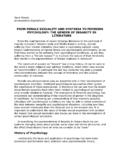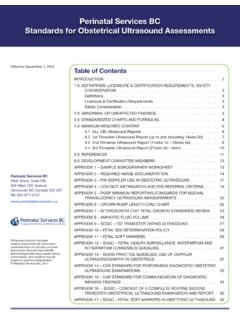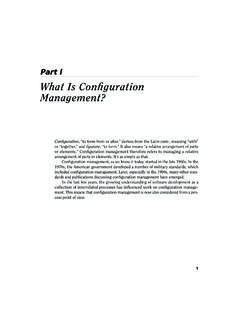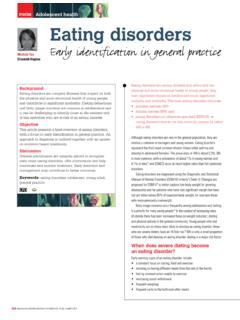Transcription of Eyewitnesses to the Past: Reclaiming Ancient Inscriptions ...
1 Eyewitnesses to the past : Reclaiming Ancient Inscriptions with modern technologies Through USC's West Semitic Research and InscriptiFact Projects by Leta Hunt Marilyn Lundberg Bruce Zuckerman West Semitic Research Project: Reason and Rationale Over the past year and a half newspapers and magazines worldwide have chronicled the account of the discovery of what may be the oldest alphabetic Inscriptions ever The two small Inscriptions were found in the Egyptian desert by Yale University archaeologists John Coleman Darnell and Deborah Darnell and photographed by a team of scholars from the West Semitic Research Project of the University of Southern California. This photographic project was one of the latest in an on-going series of endeavors by the West Semitic Research Project to use the most advanced technology for the decipherment and preservation of documents from the Ancient Near East.
2 The West Semitic Research Project came into being in the late 1970s in response to a growing awareness that the study of Ancient Inscriptions was seriously impaired by the lack of access to reliable visual data. The field of Ancient Near Eastern studies depends to a large extent on the reclamation of Ancient Inscriptions , for example, cuneiform tablets from Mesopotamia, papyri and monumental Inscriptions from Egypt, scrolls and stelae from Israel and Canaan. But in order to read these texts, scholars first have to be able to see them. Therein has existed the most serious problem inhibiting proper interpretation of the Ancient past . For example, scholars for generations have been forced to rely on what is essentially eyewitness testimony, that is, the handdrawings or transcriptions of initial editors for various text collections.
3 To be sure, such editors are almost always highly i John Noble Wilford, "Finds in Egypt Date Alphabet in Earlier Era," New York Times, Sunday, 14. November 1999, sec. 1; Karin Bojs and Daniel Famer, " ldsta alfabetet funnet i Egypten," Dagens Nyheter, 17 November 1999, sec. 1; Steve Connor, "Alphabet's Ancestor Discovered on Desert Rock," The Independent (London), Monday, 22 November 1999, sec. 1; Constance Holden, ed., "An Egyptian Birthplace for ABC's," Science, 26 November 1999, 1675; Thomas H. Maugh II, "Earliest Known Use of Alphabet Established," Los Angeles Times, Monday, 29 November 1999, sec. A; Pierre-Yves Frei, "L'alphabet remonte le temps," L'Hebdo, 2 D cembre 1999, 79; Alexandre Moix, "La vall e des lettres,". Sciences et Avenir, Janvier 2000, 10; Karine Jacquet et Caroline P neau, "A-t-on d couvert le premier alphabet?
4 " a m'int resse, Janvier 2000, 60-62; "Earliest alphabetic writing discovered in Egypt," Minerva, January/February 2000, 2; "Origin of our alphabet unearthed in Egypt," Focus, February 2000; 32; "Die Wiege des Alphabets," Specktrum, 2 Februar 2000, 10; "Gastarbeiter erfanden deas Alphabet," PM, Juni 2000, 24. trained, often brilliant scholars, who have been given the responsibility of being the first to publishing new Inscriptions precisely because they have formidable expertise. Still, in most instances it is only the initial editor who has worked with a given document or manuscript, examining it by eye and transcribing the text as he or she has best understood or interpreted it. Recognition of a particular script has often depended on the editor being a kind of connoisseur of texts one who has studied enough Inscriptions to have an informed if still subjective sense of script, language and sense.
5 This traditional approach to the dissemination of Inscriptions would not be a problem if all texts were clear, complete, and in such good condition that they could be read by anyone with the requisite knowledge and background. The difficulty arises because, in fact, most Ancient Inscriptions are damaged and incomplete, and thus the readings are open to question. New or revised editions of texts have therefore often presented competing readings of incomplete or degraded areas readings which a scholar or student has had no way of checking except by examination of the original text in a museum or at an archaeological site far distant and not readily accessible to the scholar. Photographs of Ancient Inscriptions have, of course, existed as long as photography has been widely used in archaeological and museum contexts, and many publications of texts have included photographic plates.
6 However, existing photographs rarely have been good enough to clear up questions of controversial readings essentially for these three reasons: 1) photographs have been taken by scholars or archaeologists who can read the texts well enough but do not have technical knowledge and command of the most effective photographic techniques; 2) or photographs have been taken by professional photographers who have the technical skills but cannot read the texts and therefore do not know what data to look for; and/or 3) photographs have been taken primarily for purposes of keeping an inventory or illustrating the general appearance of a text, rather than for serious study. Moreover, in far too many cases the photographic data has not been properly appreciated in terms of being the best overall reference to the primary data.
7 Indeed, following the official publication of a text the original negatives all too often have been lost, thrown away, or allowed to deteriorate beyond usefulness. A good example of this attitude toward photographs may be seen in reference to the collection of Dead Sea Scrolls photographs taken at what was then the Palestine Archaeological Museum in Jerusalem in the 1950s-1960s. Thousands of these photographs (referred to as the PAM images) exist, and they are still used and published today by those who study the Dead Sea Scrolls. However, there are serious flaws in the quality and usefulness of these photographs which inhibit a scholars ability to see and thus properly interpret the data. First, because the photographs seem to have been taken largely to document the gradual sorting of fragments into discrete manuscripts, little attention was paid to proper lighting technique.
8 The museum plates of fragments were almost always lit with only one rather harsh light from above, and without backlighting. Readings in the resulting negatives are often obscured by strong shadows, especially along fragment edges and in holes in the parchment. One cannot always tell what the true edge of a piece is, and holes can be mistaken for ink traces. Second, the PAM images were only taken with black and white infrared film. While this often allows data to be reclaimed that is unclear in visible light, IR films are notoriously poor in resolution. As a result, spots that can be seen as simple discoloration in a color photograph can be mistaken for ink, especially when the contrast is boosted in a black and white reproduction. Third, those old photographic negatives were not properly archived until the 1990s and suffered deterioration and (in the case of glass negatives) breakage.
9 A significant number are now lost and some were even inadvertently thrown out as trash, leaving only inferior prints behind. To further complicate the availability of good Dead Sea Scrolls data, the published photographs (using the old PAM negatives) are distorted in publication by the process of masking in which a clean edge is painted around a fragment. While aesthetically attractive, the masking process sometimes creates false data, or paints out data that was in the original photograph. As a student of Ancient Near Eastern Inscriptions in the 1970s Bruce Zuckerman and his colleagues were faced, therefore, with a highly frustrating state of affairs. The texts everyone was studying had often been transcribed in vastly different ways by different editors, but there was no readily available way of visually examining the Inscriptions themselves to resolve the disagreements in readings.
10 Zuckerman determined to address this problem through the establishment of the West Semitic Research Project at USC. The goal was simple: to make a visual documentation of Inscriptions with sufficient quality that they could be used for detailed study, and so that recourse to the original, often fragile, original object, would not be constantly necessary. The aim was to make anyone who so desired the eyewitness who could access the data for him or herself. The key to achieving this goal was to combine academic knowledge of the texts with technologically advanced photographic techniques. In this way truly readable photographs could be made available to a wide community of students and researchers images created not just to illustrate, but to be used for serious study.






